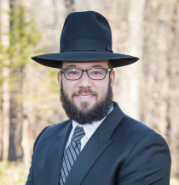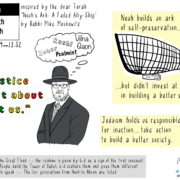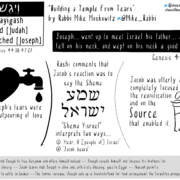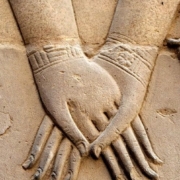Having Something Graceful to Say / Graceful Masculinity: Devarim

אֵלֶּה הַדְּבָרִים, אֲשֶׁר דִּבֶּר מֹשֶׁה אֶל-כָּל-יִשְׂרָאֵל, בְּעֵבֶר, הַיַּרְדֵּן: בַּמִּדְבָּר בָּעֲרָבָה מוֹל סוּף בֵּין-פָּארָן וּבֵין-תֹּפֶל, וְלָבָן וַחֲצֵרֹת–וְדִי זָהָב.
These are the words that Moses spoke to all of Israel, across the Jordan, in the wilderness, in the Plain, opposite the Sea of Reeds, between Paran and Tophel and Laban, and Hazeroth and Di-zahab. (Deuteronomy 1:1)
The book of Deuteronomy consists almost entirely of one exceedingly long speech delivered by Moses at the end of his life. The speech is so long that Midrash Tanchuma reports the Israelites saying, “Yesterday you said ‘I’m not a man of words”, and now you have SO much to say!”1
The people listen to all of Moses’ words. And as we read Deuteronomy between now and Simchat Torah, we listen as well. Moses does have a lot to say, and much of it is a rebuke to the Israelites for their misbehavior during the previous forty years. In our own time of great division and non-communication, we can learn a lot from Moses’ unifying final words.
Moses’ wordiness here appears out of character. In Egypt, Aaron was the talker and Moses described himself as having sealed lips (aral sefatayim). Yet over the course of their journey through the wilderness, Aaron has learned to be silent (Leviticus 10:3) and Moses has learned to speak. Rashi, on the famous verse in Ecclesiastes 3:7 “there is a time to be silent and a time to talk,” references Aaron and Moses, in that order. Each leader was able to expand beyond their natural tendency when the time called for it.
Moses’ speech begins on the first day of the month of Shvat, just 36 days before his death.2 Deuteronomy, the fifth book in the Pentateuch, is called the Mishnah Torah by the Rabbis. It’s name, משנה, can be parsed מ’ שנה – forty years. This marks the fact that 40 years have passed since Moses received the Torah at Sinai, and the children of Israel have been wandering in the wilderness for 40 years. It also alludes to the 40 generations from Moshe to Rebbe Yehudah HaNassi, who redacts the Mishna that becomes the basis of our Talmud.3
The letter מ is also the first and last letter of the Oral Law. The first mishnah in the first tractate begins with the word מאימתי and the last word of the last tractate ends with the word שלום. (me’amatai and shalom). The two מ’s together have the numerical value of 80 which corresponds to the Hebrew letter פ – peh, the mouth. This book is understood as the Torah Sheba’al Peh, the Oral Torah, in that Moshe is teaching the Divine word differently than in the first four books.4 (Notably, in his retelling, some things are different than the first time around.)
Just as it was necessary for everyone to be united by the revelation at Sinai, here also it is essential for the community to be unified in hearing Moses’ words. Rav Wolfson in his work Emunat Atich explains that all of Israel needed to be present at the same time, not just to hear Moses, but also to teach and learn from each other.5 The letter ל / lamed appears at the end of each word in the phrase אל כל ישראל, (al kol Yisrael, “to all of Israel”) and that letter ל is the root of the word לימוד / limud, meaning learning.
Today we often place ourselves in siloed, self-selected groups with the goal of having easy conversations with like-minded people. In contrast, Moses gathers all of the people, all together, for a difficult conversation. Rashi, citing the Sifrei, explains why it is crucial that everyone be present at the same time: if some folks were in the marketplace during Moses’ speech they would claim that had they been there, they could have refuted Moses. Moses speaks to everyone, engaging them with an opportunity for each individual to disagree and speak up if they choose.
The Zohar6 attributes Moshe’s success to his chein (grace) and connects him to the verse in Psalms 45:3 “grace is poured upon your lips”. The distinction between lips and speech is significant. The mystics7 observe five distinct body parts integral to speech: the (1) throat, (2) palate, (3) tongue, (4) teeth, and (5) lips. Of the 22 letters of the Hebrew Alphabet, only 4 letter sounds are articulated by the lips.8
The Sefas Emes9notes that lips are unusual in that they serve two speech functions. They both create sound, and prevent sound from leaving the mouth. Moshe uses his lips expertly. He speaks when he has something to say and is silent when he does not.
The Sefas Emes also understands the two lips as working in counterpoint together. He says the lips allude to Moses and Aaron; and later, Hillel and Shammai. The two lips also represent different attributes. Silence is din (judgement) and talking is rachamim (mercy). The Written Torah represents strictness of the law, while the Oral Torah represents mercy and compassion.10
Compassionate speech doesn’t mean indulging in one’s own desire to talk, but rather creating opportunities for people to truly hear what needs to be said. Moses’ authenticity of being, reliability of presence, and consistency of selflessness allow the words that come from his heart to enter the hearts of others. Like Moses, we must lead with love, and learn from each other.
Discussion questions:
How can we determine when we should speak and when be silent?
Is it ok to rebuke someone for doing something we ourselves do?
When someone isn’t likely to listen to what we have to say, should we still say it?
Why might the Hebrew word for “thing” דבר – davar, be the same word for speech, debar?
1. Tanchuma 2↩
2. אלה = ל”ו↩
3. Megaleh Amukos 246↩
4.Zohar Genesis 28:10↩
5. This is reflected in talmudic discussion about the proximity of teaching; even though some don’t learn from the juxtaposition of verses, in the first four books, here they do.↩
6. Parshas Bo↩
7. Sefer Yetzirah 2:3 ↩
8. בומ”פ↩
9. Succos 654-6↩
10.עיין ספר הזכות: לא איש דברים אנכי ס”ת שמאי, הוא יהיה לך לפה ר”ת הילל↩

By Rabbi Mike Moskowitz.









